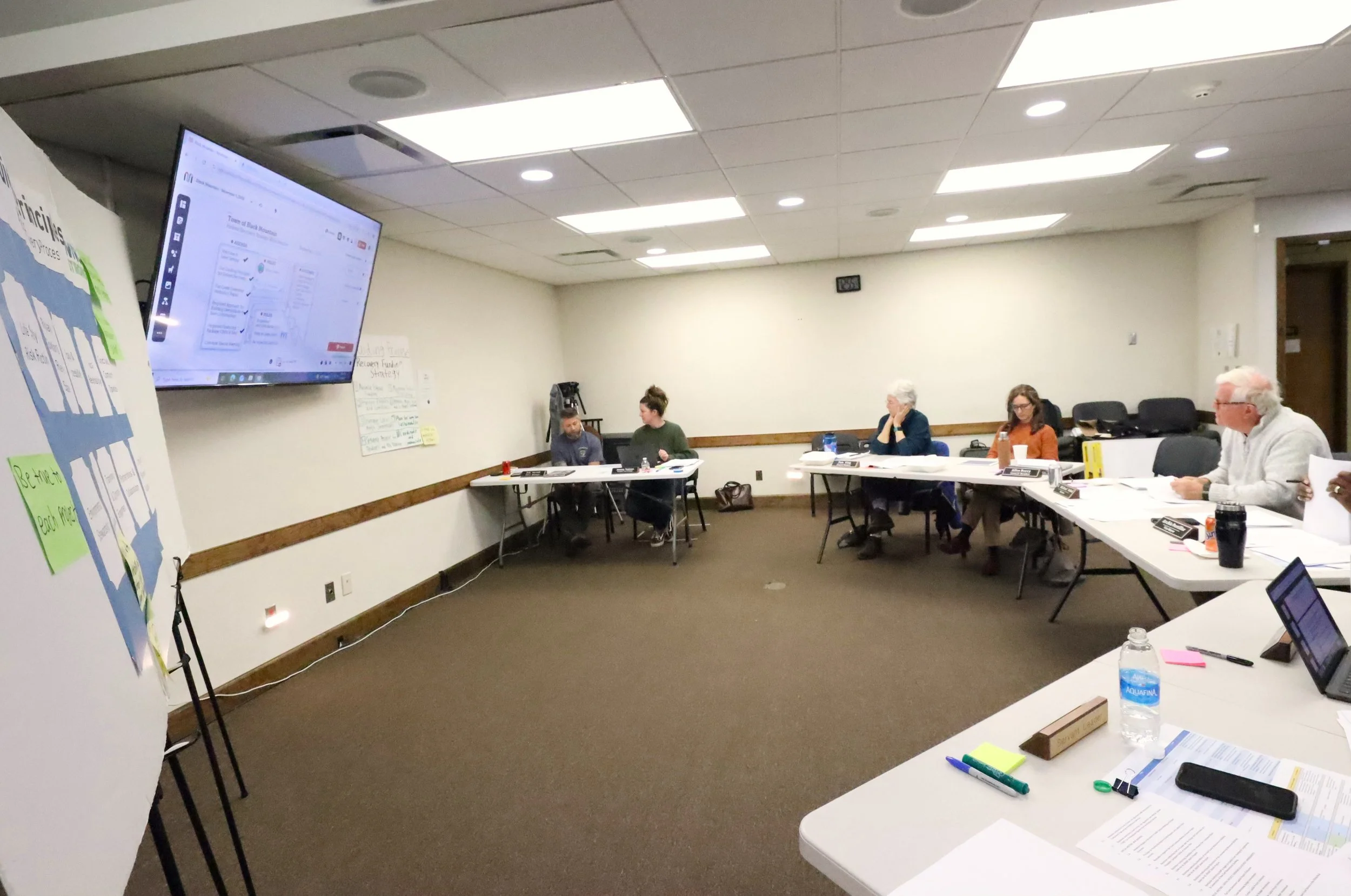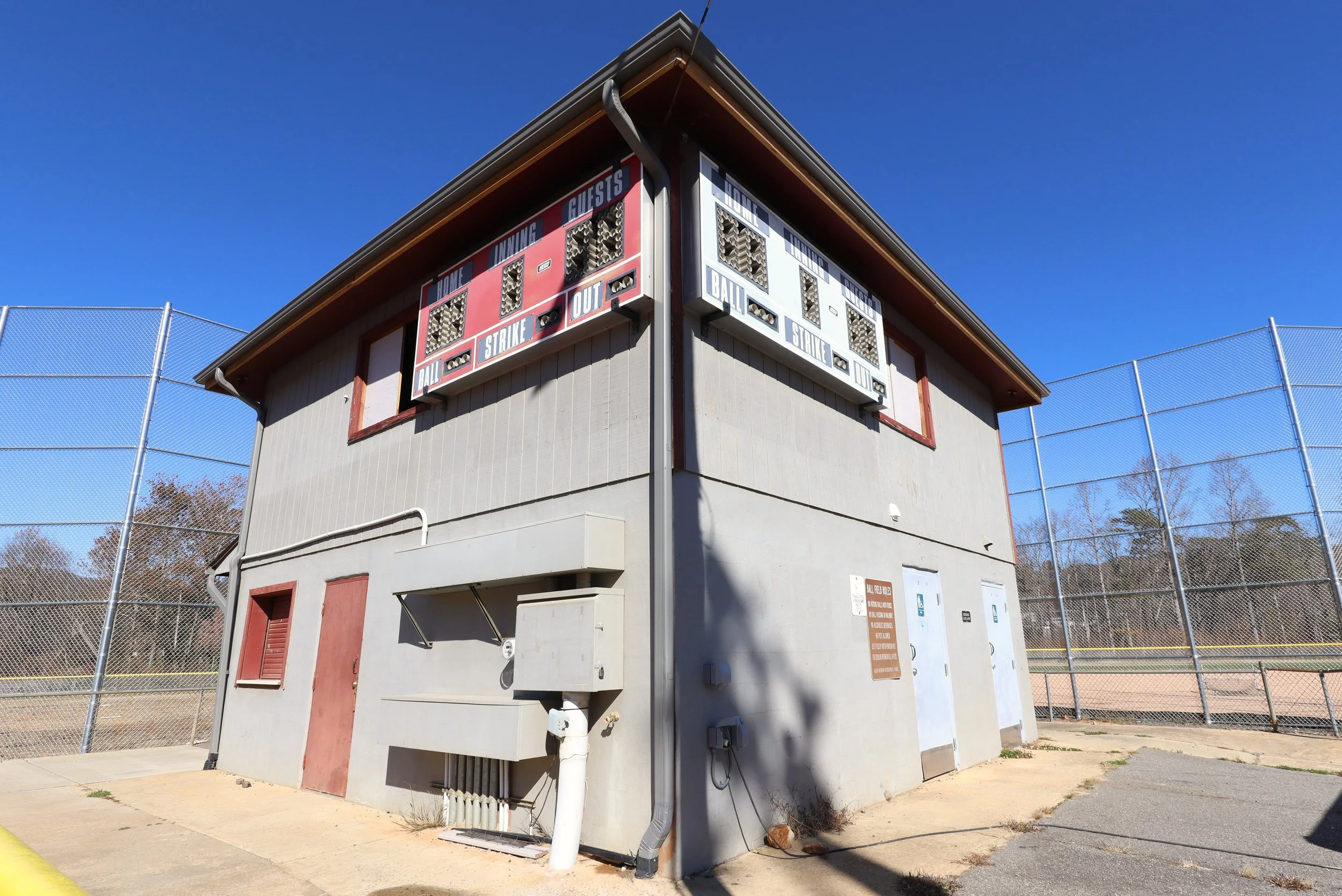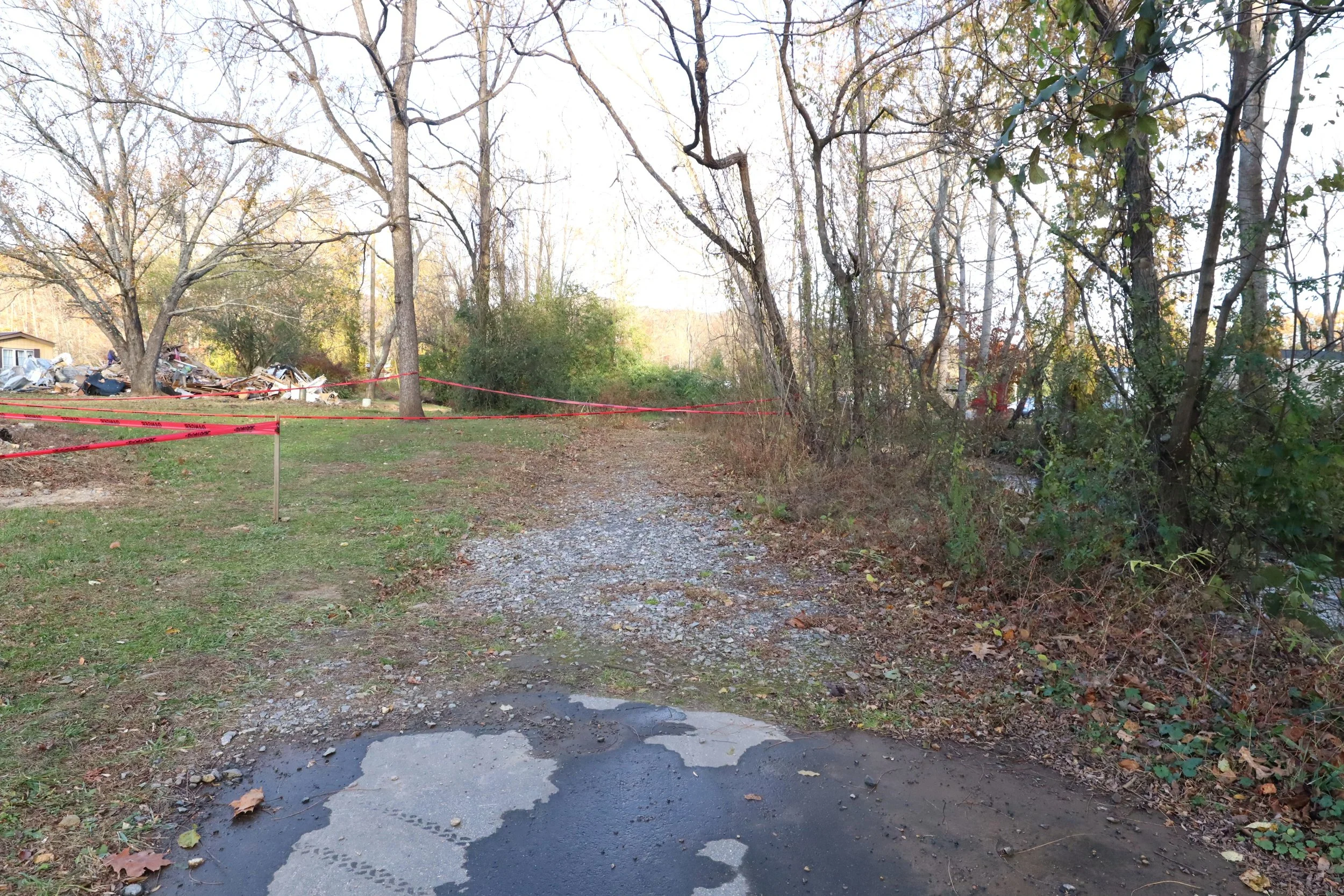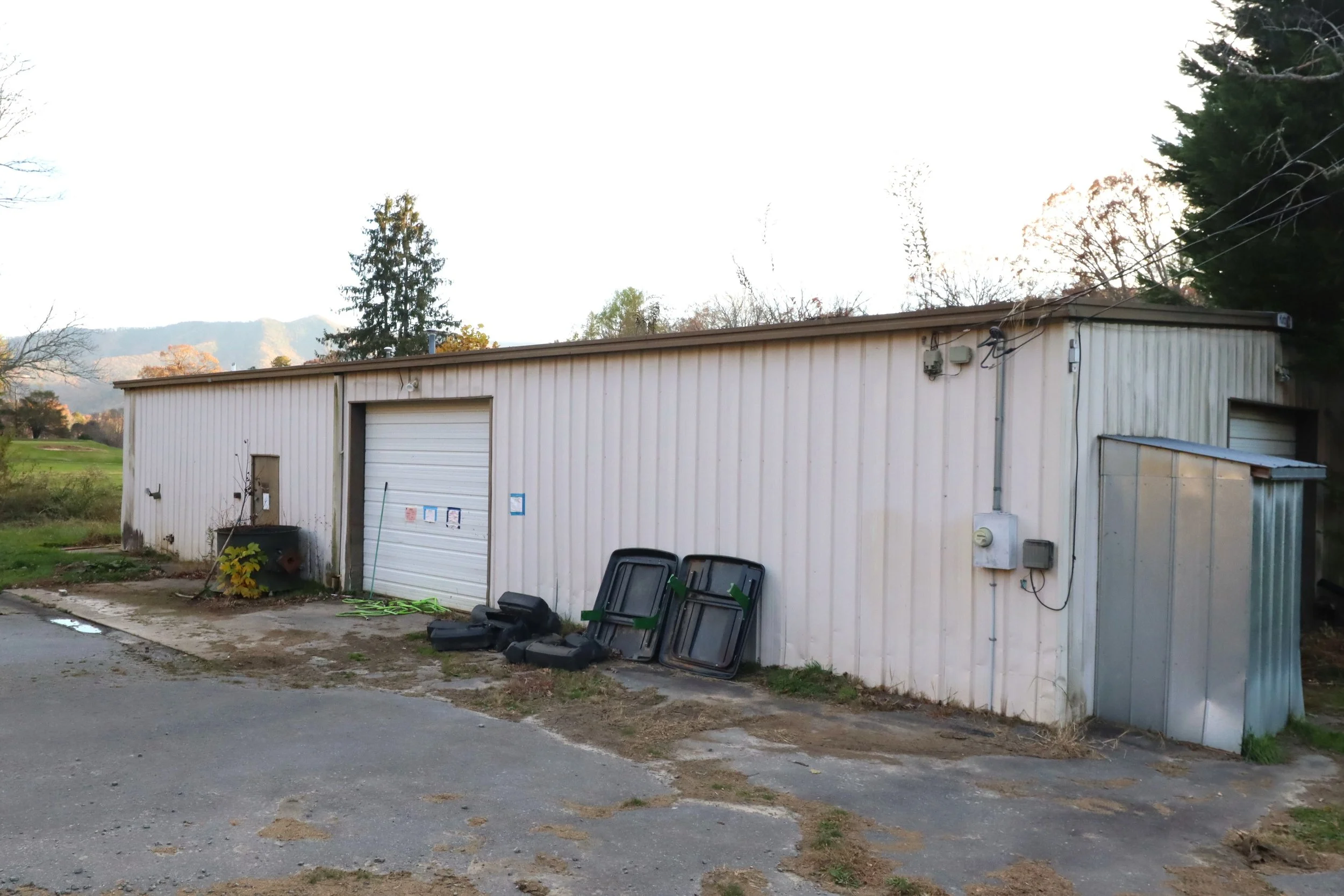Black Mountain moves forward with multiple Helene recovery projects
Town council approves demolition and construction plans, Multiple resolutions, capital projects and budget amendments
Black Mountain officials meet, Nov. 1, for a Helene recovery workshop, followed by a special called meeting of the town council. Photo by Fred McCormick
A weekend workshop for local government officials, Nov. 1, followed by a special called meeting of the town council, established guiding principles for Helene recovery and funding strategies, before the adoption of a series of resolutions, capital project ordinances and budget amendments.
The nearly four-hour gathering, which began with a session facilitated by Raleigh-based consulting firm FountainWorks, concluded with the unanimous approval of 31 individual business items.
Led by Beau Mills, a senior consultant with the firm, the work session focused on moving forward with projects related to town facilities and infrastructure damaged or destroyed by the natural disaster in September of 2024. Navigating the public assistance process that follows a catastrophic event is similar to “playing a really complicated game,” the facilitator told the town council and mayor.
“It’s really like 3D chess. If you do something here, it’s going to impact something over there,” Mills said. “You move a pawn, or a knight on a different level, you’re unsuccessful in getting funding over here, so that requires you to move money over there. It’s an amazingly complex thing.”
The meeting after the workshop, he added, was an opportunity to advance a package of items, allowing town staff the flexibility to overcome potential obstacles. The objectives of the session included the adoption of guiding principles for recovery and funding strategies; approval of design recommendations for the Flat Creek Greenway, building demolition and new construction.
“The real goal is to put these packages together, so we can really get that 3D chess game fully engaged, and move money around, working with the state and federal governments and other funding sources,” Mills said.
Principles of recovery, funding strategies and capital projects
Ten “principles of recovery to guide decision-making and project evaluation” were presented to the town council, while the resolution that accompanied the recommendations described the Town’s recovery as a multi-year effort involving federal, state and local agencies, nonprofit partners and residents. As defined in the resolution, recovery from a major disaster extends beyond rebuilding physical infrastructure to include restoration of the municipality’s “capacity, resilience and community well-being.”
Adopting a set of principles to guide the process is intended to promote consistency, transparency and accountability in the evaluation and prioritization of projects and funding decisions.
Listed in no particular order, elected officials were presented with 10 standards by which to guide the recovery process:
Life safety and risk reduction
Regulatory compliance and resilience standards
Equity and accessibility
Fiscal responsibility
Functionality and continuity of operations
Environmental stewardship
Strategic and phased implentation
Transparency and community engagement
Partnerships and collaborations
Long-term resilience and adaptation
The list is intended to provide common language when officials are making decisions related to recovery, according to assistant town manager Jessica Trotman, who authored the proposal.
“You’ll see in your agenda packet where I also used it as a scoring mechanism to try to evaluate decision points, look for opportunities to prioritize or just see how a decision aligns with the principles,” she said. “I did not start with this. I’d been working for a while when I thought about what kind of themes I found, and how can I distill those into common terms.”
A building in Veterans Park, which was constructed partially in the floodway, is one of several Town of Black Mountain buildings set to be demolished, following a Nov. 1, town council workshop and meeting. Photo by Fred McCormick
Councilmember Doug Hay requested the addition of the word “expedience” to the document.
“We can always go bigger or better and we can always continue to balance getting things done vs. weighing future options,” he said. “I don’t know if that belongs in here, but it’s something that stands out to me.”
Utilizing that terminology allows the Town to be “opportunistic and adaptive” to continuously evolving circumstances, according to Councilmember Ryan Stone.
“In my mind, that seems like it can be added to item 7, ‘strategic and phased implementation,’” he said.
A resolution establishing principles for funding strategies and guidance for decisions related to recovery and capital projects included eight proposals:
Maximize external funding
Prioritize eligibility and compliance
Leverage local match strategically
Sequence projects for readiness and risk reduction
Maintain fiscal discipline
Promote multi-use and co-benefit investments
Plan for long-term sustainability
Coordinate and communicate
Flat Creek Greenway to be moved west
Upon reaching consensus on recovery and funding guidance, the town council considered three options for a section of the Flat Creek Greenway that was washed away when flooding from the nearby body of water eroded large sections of the bank.
Restoring the trail presents a “variety of challenges,” Trotman told the board.
“One is that it’s a repetitive lost site. We already had one FEMA project there and it blew out once before that, in the same location,” she said. “It has gotten worse each time, and where we lost a section of the greenway that is now the (creek).”
Black Mountain Town Council members, in a Nov. 1, special called meeting, voted unanimously to proceed with a plan to shift the Flat Creek Greenway away from the nearby body of water. The trail is one of many facilities damaged or destroyed by Tropical Storm Helene Photo by Fred McCormick
Some sections of the path require simple repairs, but the segment claimed by the water requires alternative actions. Elected officials were asked to consider converting the greenway to an out-and-back path, ending at the re-routed creek; rebuilding the nearby stream bank and returning to the body of water to its original flow or shifting the trail away from Flat Creek, which would require an easement agreement with the property owner.
All five members of the town council agreed to relocate the trail slightly west of its original course, while Mayor Mike Sobol offered to contact the property owner on behalf of the town.
“We have to follow the process, but we can’t even get to the process unless somebody sits down with him," Sobol said. “You can’t score if you’re not on base.”
Councilmember Alice Berry reiterated that any additional details regarding an agreement would require discussion by the town council.
“I’m just trying to get the door open so we can talk, and then we can proceed with that process,” Sobol replied.
The town council agreed to allow the mayor to represent the town while making initial contact with the land owner.
“I will let our FEMA and engineering teams know that our preferred method is acquisition of property going to the west,” Trotman said.
Demolition and new construction
While many recovery projects were not discussed during the session, due to multiple factors, including pending status with FEMA, Trotman reviewed 11 projects that have secured funding through state bridge loans, insurance proceeds or the town’s unrestricted Helene fund balance.
Bridge loans acquired through the NC Department of Environmental Quality are expected to cover the estimated $1.1 million cost of engineering and construction to repair a sinkhole on South Oconeechee Avenue, while $1 million will fund engineering and initial estimates to fix leaking lines within the town’s water system. Funding acquired through the NC DEQ Bridge Loan program can not be applied to properties not eligible for federal reimbursement, the assistant town manager told the council.
Projects funded through the N.C. State Bridge Loan Program include $35,000 to cover engineering costs for the proposed section of the Flat Creek Greenway and $120,000 for engineered solutions for a replacement bridge in Veterans Park. Other projects funded by the loan program include $475,000 for engineering and construction for repairs of the Lake Tomahawk spillway and an additional $250,000 for the dam. An additional $542,000 granted from the loan program will be combined with approximately $300,000 of budgeted town funds and $59,000 through a FEMA advance payment to fix a washed out section of Hilltop Road.
A maintenance shed on the Black Mountain Golf Course will be demolished, following a Nov. 1, special called meeting of the town council. The municipality plans to seek grant funding to replace the structure, which was constructed within the floodway. Photo by Fred McCormick
“This gets us done with the design, roadway, all of it,” Trotman said., adding the design was nearing 90% completion.
Projects not eligible for FEMA assistance, including the public safety building, concession stand and press box at Veterans Park, the golf course maintenance structure and town funds matching a Federal Highway Administration grant for portions of Cragmont Road, will require staff to apply for state capital grant funding.
Resolutions authorizing the demolition of the concession stands and nearby restroom building in Veterans Park, and subsequent debris removal, were approved unanimously by the town council. The golf course maintenance structure will also be removed.
All buildings set for demolition are located at least partially in a floodway, rendering them out of compliance with the National Flood Insurance Program, according to Trotman, and unable to be properly insured.
“These are buildings that were never legally built, so therefore they are non-conforming and don’t benefit from any grandfathering concept, or anything like that. Plus, they are not eligible for FEMA (Public Assistance),” she said. “Then, we can apply for the new State Capital Grant Fund.”
Established last June as the Helene Local Government Capital Grant program, the funding source, officially announced Sept. 22, is designed to assist local municipalities with repairs to storm-damaged infrastructure.
“It is specifically for things that are not eligible for FEMA PA, and related to recovery,” Trotman said. “We have a resolution that lists things to apply for.”
The town plans to seek $1 million in grant funding to construct a new golf course maintenance shop near the 17th green, and additional funding for a NFIP-compliant building at Veterans Park, near the current restroom building.
“It would be resilient, elevated, flood-proof, concession stand, restrooms, all in one thing, and not be in violation of any of the NFIP,” Trotman said. “It would not clip the floodway, like the concession stand currently does, and it would also be insurable.”
The deadline for the grant application is in three weeks, she added.
“We are also pursuing Golden Leaf (Foundation) for the concession stand and restroom building,” Trotman said.




